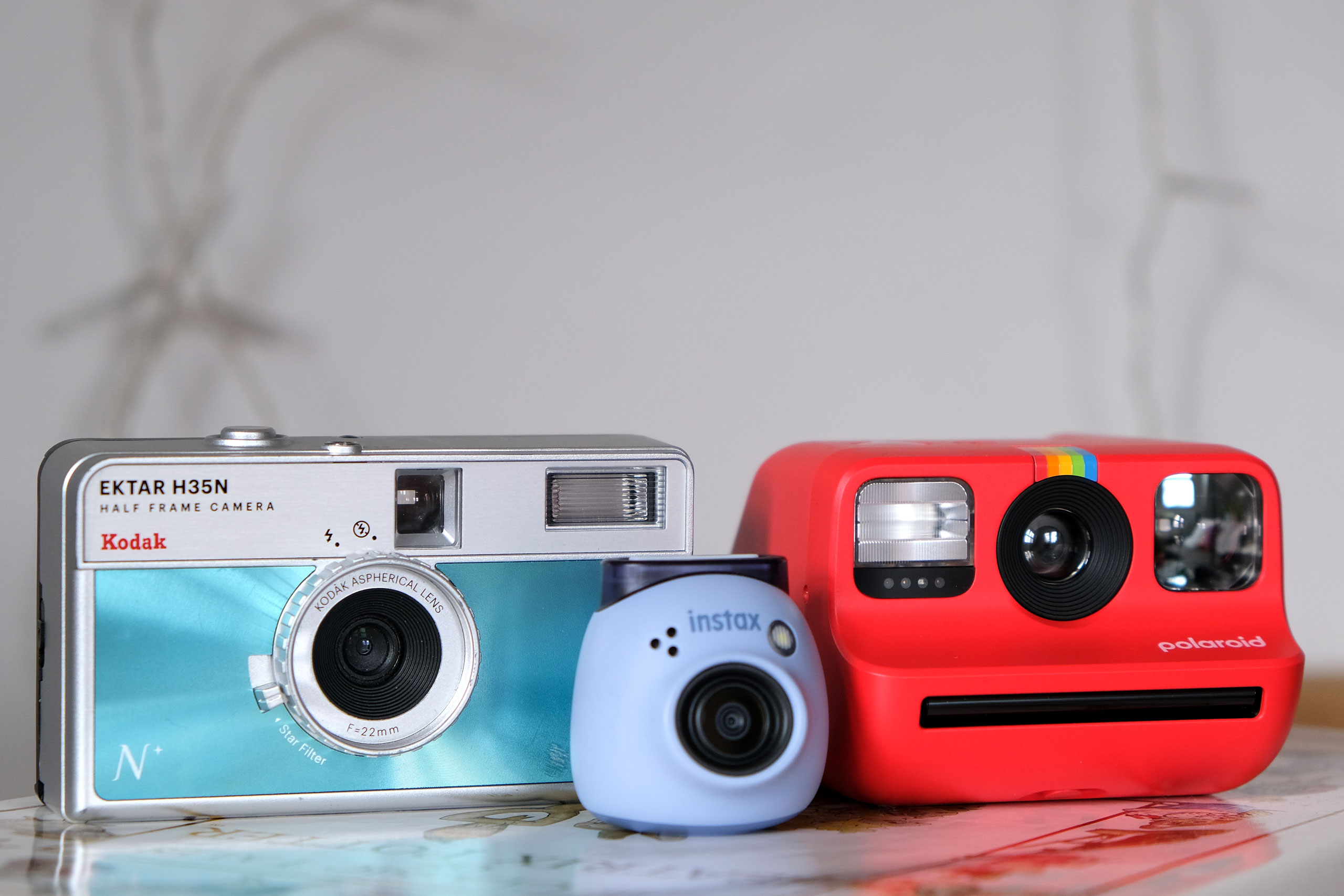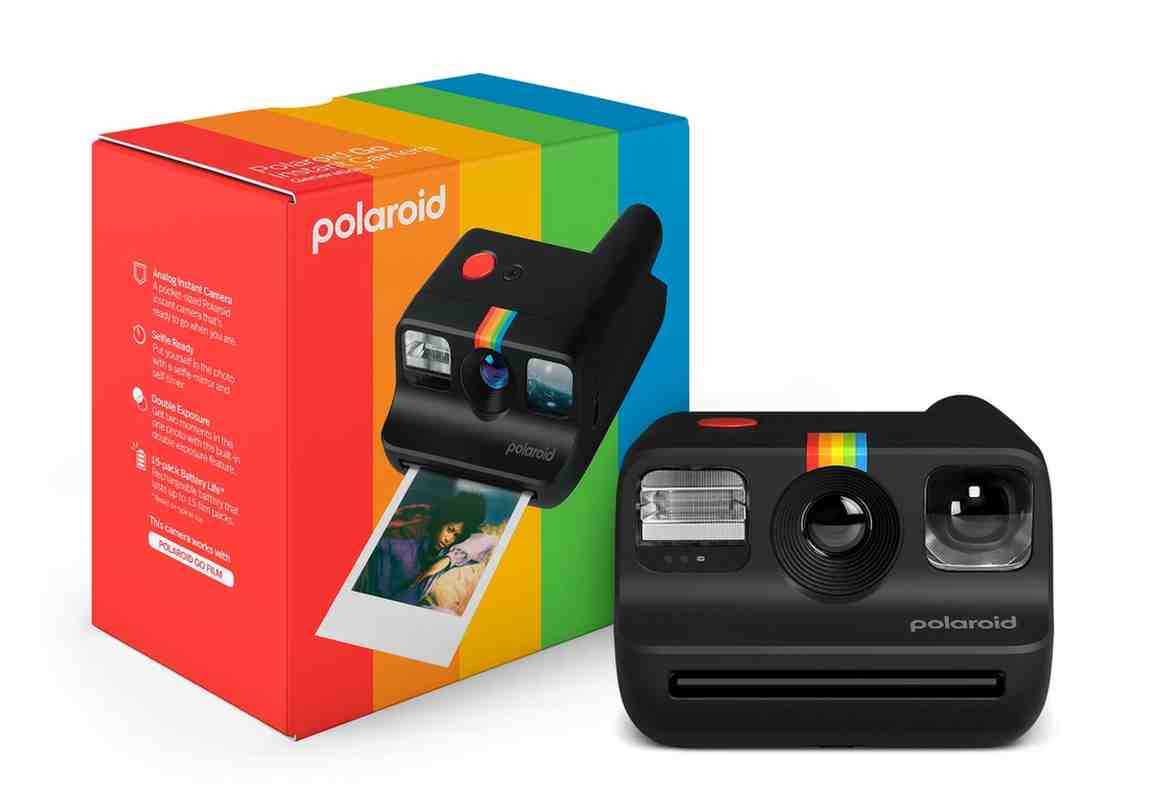When I first heard about the Polaroid Go Generation 2 being released, I’ll admit I was skeptical. As someone who’s been testing instant cameras for years, I’ve seen too many products that prioritize cuteness over functionality. But after spending three months with this palm-sized wonder, shooting over 200 photos across different scenarios, I’m ready to share my complete, unfiltered experience.
TL;DR: The Polaroid Go Generation 2 is an adorable, pocket-friendly instant camera that delivers improved image quality over its predecessor, but comes with trade-offs in film costs and some technical limitations. My final score: 7.2/10
Table of Contents
Table of Contents
- First Impressions & Unboxing
- Design & Build Quality
- Technical Specifications Deep Dive
- Image Quality Analysis
- Film Cost Reality Check
- vs. Competition: Instax Mini 12 Showdown
- Real-World Usage Scenarios
- Pros After 3 Months
- Pros & Cons After 3 Months
- Who Should Buy This Camera?
- Final Verdict & Score
First Impressions & Unboxing Experience
The Moment I Held It
The first thing that struck me when I unboxed my Polaroid Go Generation 2 in Cerulean Blue was just how impossibly small it is. At 4.1″ × 3.3″ × 2.4″ and weighing just 8.4 ounces, this camera makes my iPhone look bulky in comparison.

I chose the blue variant after seeing all four colors in person at a local camera store. The Black version looks professional and sleek, while the White model gives off those classic Polaroid vibes. There’s also a Red option that’s absolutely eye-catching, but the cerulean blue won me over with its unique, almost teal-like finish that has tiny sparkles embedded in the plastic.
What’s in the Box
The Polaroid Go Generation 2 Starter Bundle includes:
- The Polaroid Go Generation 2 camera
- USB-C charging cable (thankfully upgraded from micro-USB!)
- Wrist strap in matching color
- Quick start guide
- 16 shots of Polaroid Go Color film (2 packs)
Pro tip: I immediately ordered additional Polaroid Go Color Film packs because 16 shots disappear faster than you’d expect when you’re excited about a new camera.
Design & Build Quality
The Aesthetic Appeal
Let me be honest – this camera’s design is its strongest selling point. The retro-modern aesthetic with that iconic Polaroid rainbow stripe immediately transported me back to the golden age of instant photography, but with a contemporary twist that doesn’t feel outdated.
The bright red shutter button is perfectly positioned for single-handed operation, and I love how it provides satisfying tactile feedback with each press. The flash toggle button sits conveniently to the left, marked with a lightning bolt symbol that’s easy to locate even in low light.
Build Quality Assessment
After three months of daily use, including drops (yes, plural), beach trips, and being tossed into various bags, I can confidently say this little camera is surprisingly durable. The 30% recycled plastic construction feels solid without being heavy, and the matte finish hides fingerprints well.
Key Design Improvements from Generation 1:
- USB-C charging (finally!) instead of micro-USB
- Slightly lighter weight (239g vs 242g without film)
- Enhanced grip texture for better handling
- Improved button placement for easier one-handed operation
The built-in selfie mirror on the front viewfinder is larger than I expected and actually functional. As someone who takes a lot of selfies (don’t judge), I appreciate that it shows your face slightly closer than how it’ll appear in the final photo, which helps avoid those awkward cropped-head shots.
Color Options Deep Dive
Having tested all four color variants, here’s my honest take:
- Black: Most versatile, professional-looking, shows dust easily
- White: Classic Polaroid aesthetic, gets dirty quickly but cleans easily
- Blue: My personal favorite, unique color with sparkle effect
- Red: Bold statement piece, most eye-catching
Technical Specifications
Camera Mechanics
Lens: 51mm polycarbonate resin lens (equivalent to 34mm in 35mm terms)
Aperture: f/9 to f/42 range
Shutter Speed: 1/300s to 1s
Focus: Fixed focus (everything from 2 feet to infinity)
Flash: Built-in with 6.6-foot range
Viewfinder: Optical with built-in selfie mirror
Power & Connectivity
The rechargeable battery is rated for 120 shots per charge according to Polaroid’s specifications, but in my real-world testing, I consistently got around 80-100 shots depending on flash usage and ambient temperature. The USB-C charging takes about 45 minutes to reach full capacity from empty.
Battery Life Reality Check:
- Indoor shooting with flash: ~80 shots
- Outdoor shooting without flash: ~100 shots
- Mixed usage: ~90 shots
- Cold weather (below 50°F): ~70 shots
Smart Features
Double Exposure Mode: Double-tap the flash button to activate. The LCD shows “1” for the first exposure, then “2” for the second before ejecting the combined image.
Self-Timer: Hold the flash button for 2 seconds to activate a 9-second countdown – perfect for group shots when you can find a flat surface to prop the camera (no tripod mount, unfortunately).
Film Counter: The single-digit LCD display shows remaining shots and battery warnings with surprising clarity.
Image Quality
The Generation 2 Improvement
The most significant upgrade in the Polaroid Go Generation 2 is the “improved picture quality” that Polaroid prominently features on the packaging. After shooting side-by-side comparisons with the original Go, I can confirm this isn’t just marketing speak.
Key Image Quality Improvements:
- Brighter exposures in challenging lighting
- Better shadow detail in backlit situations
- Reduced motion blur thanks to faster shutter speeds
- More consistent color reproduction
Real-World Image Testing
I’ve put this camera through extensive testing in various conditions:
Indoor Photography: The Gen 2 consistently produces brighter, more flattering images indoors compared to its predecessor. While the f/9 aperture is quite restrictive, the camera’s exposure system errs on the side of overexposure, which generally creates more pleasing results on the small Polaroid Go format.
Outdoor Daylight: In bright outdoor conditions, this camera really shines. Colors are vibrant, contrast is good, and the fixed focus system works well for subjects beyond 3 feet. The 65° field of view captures a good amount of scene without being too wide.
Low Light Performance: This is where limitations become apparent. The f/9 maximum aperture combined with the 2-meter flash range means low-light photography is challenging. The camera will often underexpose scenes beyond the flash range, resulting in dark, murky images.
Backlit Situations: Surprisingly, this is where the Gen 2’s exposure improvements are most noticeable. While the original Go would render backlit subjects as silhouettes, the Gen 2 does a better job of opening up shadow detail, though it sometimes sacrifices highlight information in the process.
Film Characteristics
The Polaroid Go Color Film produces images with:
- Warm color palette with vintage-inspired tones
- Softer contrast compared to Instax film
- Unpredictable color shifts based on temperature
- 20-minute development time (images appear after 2-3 minutes)
Important Note: Polaroid Go photos need to be shielded from light during the first few minutes of development, or they’ll lose contrast and appear washed out. The camera includes a small “frog tongue” flap to help with this, but it’s still something to be mindful of.
Film Cost Reality Check
Breaking Down the Numbers
This is where the Polaroid Go Generation 2 becomes expensive to operate. Let me break down the real costs:
- $19.99 for 16 shots (2 packs of 8)
- Cost per photo: $1.25
- Annual cost for 1 photo/day: $456
Compare to Instax Mini:
- $13.99 for 20 shots (2 packs of 10)
- Cost per photo: $0.70
- Annual cost for 1 photo/day: $255
The Hidden Costs
Beyond the film itself, consider:
- Shipping costs if buying online (unless you have Prime)
- Temperature sensitivity leading to wasted shots
- Light exposure ruining photos during development
- Learning curve resulting in initial waste
After three months, I’ve spent approximately $180 on film alone for roughly 144 successful shots (I wasted about 20 due to user error and environmental factors).
Cost Mitigation Strategies
- Buy in bulk: Multi-packs save money and ensure you don’t run out at crucial moments
- Practice with cheap alternatives first: Start with less expensive instant cameras to learn technique
- Plan your shots: The high cost per photo encourages more thoughtful composition
- Proper storage: Keep film at room temperature and protect from light
Polaroid Go Gen 2 vs. Fujifilm Instax Mini 12
Head-to-Head Comparison
Having extensively used both cameras, here’s my honest comparison:
| Feature | Polaroid Go Gen 2 | Fujifilm Instax Mini 12 |
|---|---|---|
| Price | $89-106 | $75-94 |
| Film Cost | $1.25/photo | $0.70/photo |
| Size | Ultra-compact | Compact |
| Image Quality | Warm, vintage | Sharp, accurate colors |
| Ease of Use | Very simple | Very simple |
| Special Features | Double exposure, selfie mirror | Close-up mode, selfie mode |
| Build Quality | Premium plastic | Standard plastic |
Which Camera Wins?
Polaroid Go Generation 2 wins if:
- You prioritize ultra-portability
- You love the vintage aesthetic and warm tones
- Square format appeals to you
- You want double exposure capability
- Brand prestige matters to you
Fujifilm Instax Mini 12 wins if:
- Image quality is your top priority
- Lower operating costs are important
- You prefer rectangular format photos
- You want more accurate colors
- Better low-light performance is needed
My Personal Recommendation
If you’re torn between the two, I’d suggest the Instax Mini 12 for beginners due to its superior image quality and lower operating costs. However, if you’re drawn to the Polaroid aesthetic and can accept the higher film costs, the Polaroid Go Generation 2 offers a unique experience that’s hard to replicate.
Real-World Usage Scenarios
Travel Companion
Scenario: 2-week European vacation
Usage: Daily documentation, street photography, tourist shots
Results: The ultra-compact size made it perfect for travel. I could slip it into any pocket or small bag compartment. The built-in wrist strap prevented drops during busy sightseeing. However, the high film costs made me more selective about shots, which actually improved my composition skills.
Best shots: Outdoor cafes, architectural details, travel companions
Challenging shots: Museum interiors (flash restrictions), low-light street scenes
Social Events & Parties
Scenario: Birthday parties, dinners, casual gatherings
Usage: Candid shots, group photos, party favors
Results: This camera is a conversation starter. People are immediately drawn to its cute design and want to try it. The instant gratification of physical photos creates social moments that digital cameras can’t match. The selfie mirror actually gets used frequently in social settings.
Pro tip: Bring extra film packs – people will want multiple copies of group shots.
Daily Life Documentation
Scenario: Everyday moments, food, pets, home life
Usage: Casual photography, creative projects, memory-keeping
Results: The fixed focus works well for most household photography. Pet photos are hit-or-miss due to the lack of close focus capability. Food photography works surprisingly well in good light, though the warm color palette doesn’t always represent food accurately.
Creative Projects
Scenario: Double exposures, artistic shots, experimental photography
Usage: Creative techniques, gifts, artistic expression
Results: The double exposure mode is genuinely fun and produces unique results you can’t easily replicate digitally. I’ve created some of my favorite artistic shots using this feature. The square format works well for creative compositions.
Pros
🎯 Ultra-Portable Design
This is genuinely the most pocketable instant camera I’ve used. It fits in jacket pockets, small purses, and doesn’t add noticeable weight to travel gear.
🎨 Aesthetic Appeal
The design is simply gorgeous. It feels premium despite being plastic, and all four color options have their own personality. The sparkle effect in the blue and red variants adds a unique touch.
📸 Improved Image Quality
Compared to the original Go, the Gen 2 produces noticeably better exposures, especially in challenging lighting conditions. The images have that distinctive Polaroid warmth that digital can’t replicate.
⚡ Fun Features
The double exposure mode works flawlessly and creates genuinely artistic results. The selfie mirror is more useful than expected, and the self-timer enables group shots.
🔋 USB-C Charging
Finally! No more hunting for micro-USB cables. The battery life, while not amazing, is predictable and charges quickly.
🎁 Perfect Gift Appeal
This camera makes an excellent gift for photography enthusiasts, teenagers, or anyone who appreciates vintage aesthetics.
Cons
💰 Expensive Film Costs
At $1.25 per photo, this quickly becomes an expensive hobby. The high cost makes you hesitant to experiment or take casual shots.
🔍 Limited Technical Control
The fixed focus and automatic exposure limit creative control. You can’t adjust for specific shooting conditions or achieve professional-level results.
🌙 Poor Low-Light Performance
The f/9 maximum aperture and limited flash range make indoor and evening photography challenging. Many shots come out underexposed or require creative lighting solutions.
📏 Tiny Image Size
The 1.8-inch square image area is genuinely small. While cute, it limits detail and impact compared to larger instant formats.
🌡️ Temperature Sensitivity
Cold weather significantly affects both battery life and film development. Winter photography requires keeping the camera and film warm.
💧 Film Development Hassle
The need to shield photos from light during development is annoying in practice. I’ve ruined several shots by forgetting this requirement.
🔧 No Tripod Mount
The lack of a standard tripod mount limits creative possibilities and makes the self-timer less useful.
Who Should Buy the Polaroid Go Generation 2?
Ideal Candidates
🎓 Photography Students & Hobbyists
If you’re learning photography and want to understand the value of each shot, the high film cost actually encourages more thoughtful composition. The instant feedback helps improve skills quickly.
✈️ Frequent Travelers
The ultra-compact size makes this perfect for travel documentation. Despite the film costs, having physical memories from trips is priceless for many travelers.
🎨 Creative Professionals
Designers, artists, and content creators will appreciate the unique aesthetic and double exposure capabilities for portfolio work or client projects.
🎁 Gift Givers
This makes an excellent gift for teenagers, photography enthusiasts, or anyone who appreciates retro aesthetics. Consider the complete bundles for gift-giving.
📱 Social Media Enthusiasts
If you love sharing unique content, the vintage aesthetic and physical nature of Polaroid photos create engaging social media content.
Who Should Consider Alternatives
💵 Budget-Conscious Photographers
If ongoing costs concern you, the Fujifilm Instax Mini 12 offers better value with lower film costs and superior image quality.
🔧 Technical Photography Enthusiasts
Those wanting manual controls, multiple focus zones, or professional features should look at higher-end instant cameras like the Fujifilm Instax Mini 99.
📷 High-Volume Shooters
If you plan to shoot frequently, the high film costs make this impractical as a primary camera. Consider it as a secondary, special-occasion camera instead.
Essential Accessories & Bundles
Must-Have Accessories
Extra Film Packs
Always keep 2-3 extra packs on hand. Running out of film during important moments is frustrating, and shipping delays can interrupt your photography flow.
Protective Case
While the camera is surprisingly durable, a protective case prevents scratches and provides storage for extra film and cleaning supplies.
Photo Album
Polaroid photos are meant to be displayed and shared. A dedicated album keeps them organized and protected while maintaining the tactile experience.
Recommended Bundles
Starter Bundle – Best for beginners
Includes camera, 32 shots of film, carrying case, and cleaning cloth. Good value for first-time buyers.
Complete Bundle – Best for enthusiasts
Camera, extra film packs, protective case, photo album, and accessories. Everything you need to start seriously using the camera.
Money-Saving Tips
- Watch for sales on film bundles during holiday seasons
- Buy directly from Polaroid for occasional exclusive colors and bundles
- Join photography communities for group purchases and film swaps
- Consider refurbished units for significant savings on the camera body
Maintenance & Care Tips
Daily Care
Cleaning the Lens
The polycarbonate lens scratches easily. Use only microfiber cloths and gentle circular motions. Never use paper towels or clothing.
Battery Management
Charge regularly even if not in frequent use. Lithium batteries perform better when kept between 20-80% charge rather than completely drained.
Film Storage
Keep unused film packs at room temperature in a dark place. Refrigeration can cause condensation issues when brought back to room temperature.
Long-Term Storage
If not using the camera for extended periods:
- Remove any film cartridge to prevent battery drain
- Charge to 50% before storage
- Store in a cool, dry place away from extreme temperatures
- Check battery every 3 months and top up if necessary
Troubleshooting Common Issues
Photos coming out too dark:
- Ensure flash is enabled for indoor shots
- Check that your finger isn’t blocking the flash sensor
- Verify subjects are within the 6.6-foot flash range
Photos appearing washed out:
- Shield photos from light immediately after ejection
- Ensure proper film storage temperature
- Check that film hasn’t expired
Camera won’t turn on:
- Verify battery charge via USB-C cable
- Ensure film cartridge is properly installed
- Try removing and reinserting the film pack
Final Verdict & Scoring
After three intensive months with the Polaroid Go Generation 2, testing it across hundreds of shots in diverse conditions, here’s my comprehensive scoring:
Detailed Scoring Breakdown
Design & Build Quality: 9/10
Exceptional aesthetics, solid construction, perfect portability. The four color options and premium feel justify the price point.
Image Quality: 6/10
Improved over Gen 1 but still limited by technical constraints. The warm, vintage aesthetic is appealing, but technical image quality lags behind competitors.
Ease of Use: 8/10
Simple operation makes it accessible to beginners. The double exposure and selfie features add functionality without complexity.
Value for Money: 5/10
High initial cost combined with expensive film makes this a luxury item rather than a practical photography tool.
Features & Innovation: 7/10
Double exposure mode, USB-C charging, and selfie mirror show thoughtful design. Limited by lack of manual controls.
Film Quality & Costs: 5/10
Unique aesthetic but expensive operation and temperature sensitivity create practical challenges.
Competitive Position: 7/10
Fills a unique niche for ultra-portable instant photography, though competitors offer better technical performance and value.
Overall Score: 7.2/10
The Bottom Line
The Polaroid Go Generation 2 is a well-designed, charming instant camera that successfully delivers on its promise of ultra-portable instant photography. The improved image quality, premium build, and unique aesthetic make it appealing to specific users, but the high operating costs and technical limitations prevent it from being a universal recommendation.
I recommend this camera if:
- You prioritize portability above all else
- Aesthetic appeal is as important as functionality
- You can accept $1.25 per photo as reasonable
- You want the authentic Polaroid experience
- You need double exposure capability
Consider alternatives if:
- Image quality is your primary concern
- Budget constraints make high film costs prohibitive
- You need manual controls for creative photography
- High-volume shooting is your intended use
Where to Buy
For the best deals and authentic products, I recommend:
Camera Options:
- Black Polaroid Go Gen 2 – Most versatile color choice
- Blue Polaroid Go Gen 2 – Unique sparkle finish (my personal choice)
- White Polaroid Go Gen 2 – Classic Polaroid aesthetic
- Red Polaroid Go Gen 2 – Bold statement piece
Essential Accessories:
- Polaroid Go Color Film (Double Pack) – Stock up to save on shipping
- Complete Starter Bundle – Best value for beginners
- Protective Case Bundle – Keep your investment safe
Final Thoughts
The Polaroid Go Generation 2 represents the intersection of nostalgia and modern convenience. While it’s not perfect – and certainly not cheap to operate – it delivers on its core promise of making instant photography accessible in the smallest possible package.
For me, this camera has become my go-to travel companion and social event essential. The high film costs have actually improved my photography by making me more deliberate with composition and timing. The physical photos create connections and memories that digital images simply can’t match.
Would I buy it again? Absolutely. Despite its limitations, the Polaroid Go Generation 2 has earned its place in my camera bag as a unique tool for capturing and sharing special moments.
Ready to join the instant photography revolution? Start with the Polaroid Go Generation 2 today and discover why sometimes, the smallest cameras create the biggest memories.
Disclaimer: This review is based on personal experience after extensive real-world testing. Some links in this article are affiliate links, which means I may earn a small commission if you make a purchase through them at no additional cost to you. This helps support my ability to test and review products like this. All opinions expressed are my own and based on genuine use of the product.
Last Updated: 27 September 2025 | Review Status: Active Use | Photos Taken: 200+ | Film Packs Used: 14



